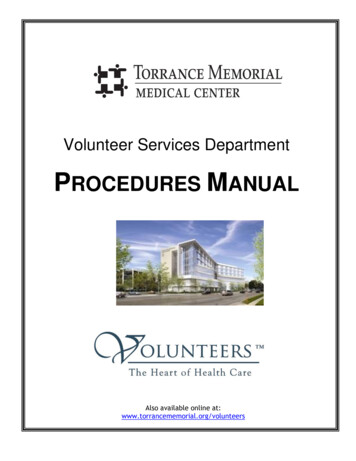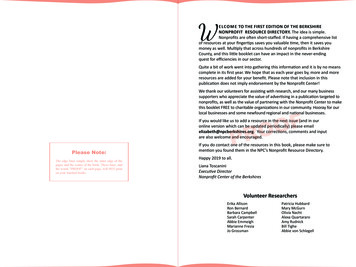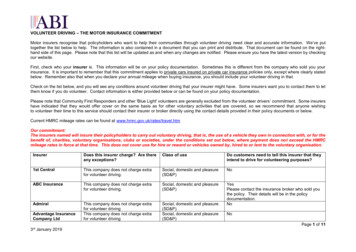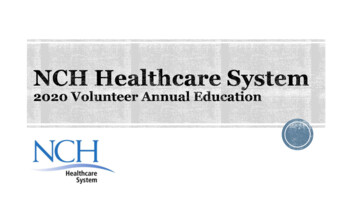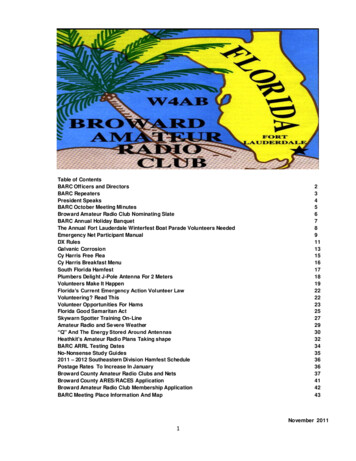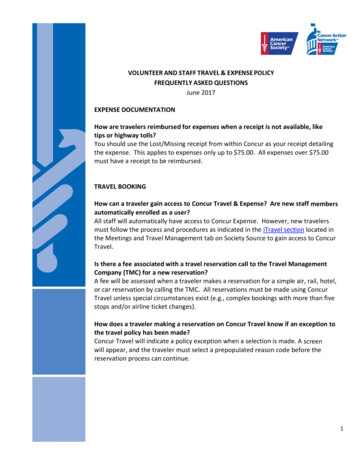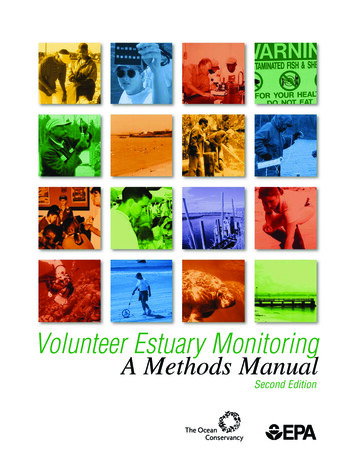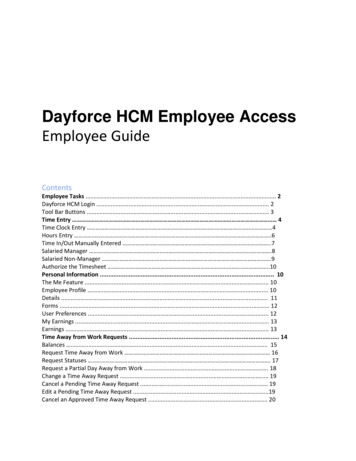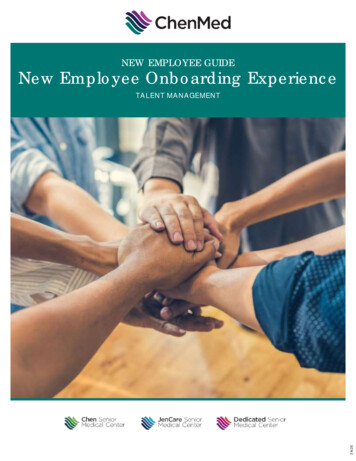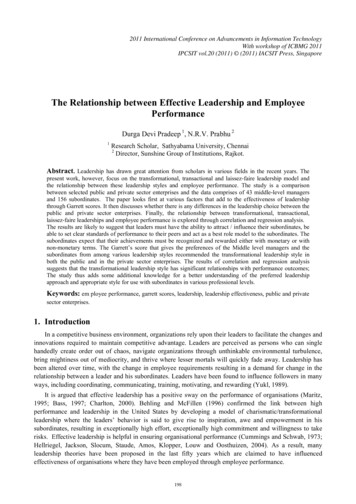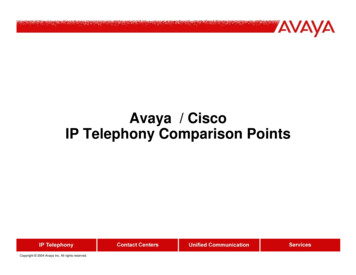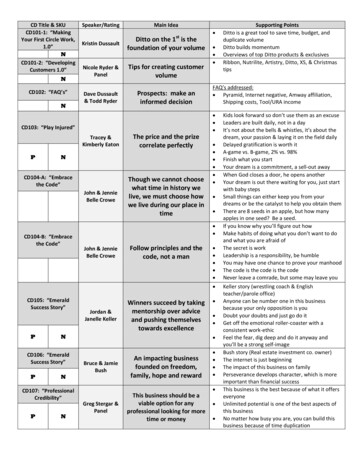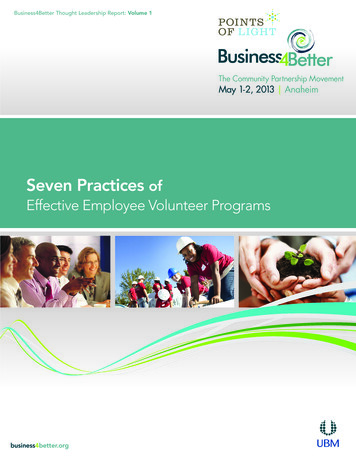
Transcription
Business4Better Thought Leadership Report: Volume 1Seven Practices ofEffective Employee Volunteer Programsbusiness4better.org
Seven Practices of EffectiveEmployee Volunteer ProgramsEmployee volunteerism is not a new concept. Moreand more companies are recognizing the value thatproviding service opportunities to employees bringsto the company, the employees themselves and, ofcourse, communities across the globe.As the economy starts to rebound and employees have a choice in employers, there is all themore reason to highlight innovative ways in which companies recruit, retain, and developtheir employees. Employers will be increasingly challenged to attract and retain theirbest talent while facing pressure to keep costs neutral. Employee engagement is crucial tosucceeding in this and there’s no better way to engage employees than through volunteerism.What is an Employee Volunteer Program (EVP)?An Employee Volunteer Program (EVP) is defined as a planned, managed effort thatseeks to motivate and enable employees to effectively serve community needs through theleadership of the employer. EVPs, also called workplace volunteer programs or employersupported volunteer programs, are typically one component of a company’s corporate socialresponsibility (CSR) program, community engagement program (CEP), or other programthat addresses the company’s involvement in societal causes.Why are EVP programs important?Gone are the days when employee volunteerism was thought of as fluff, an afterthought, or anice gesture. Research shows that employee volunteerism has many advantages including: I mproves corporate image and relations with stakeholders through positioning as a leaderin giving back at the local and national level. Develops and enhances employees’ professional and leadership skills. S upports specific business functions, most often in the areas of human resources andexternal relations.ABOUT POINTS OF LIGHTPoints of Light is the largest organization in the worlddedicated to volunteer service. We bring the power ofpeople to bear where it matters most. After 20 yearsof developing, enhancing and rewarding EmployeeVolunteer Programs, we understand what makes themsuccessful.2business4better.org
Seven Practices of EffectiveEmployee Volunteer Programs B oosts employee morale, team building, loyalty, productivity, motivation and reducesabsenteeism.Research indicates that EVPsthat achieve high impact for Attracts new hires, especially millenials.both the community and R eaches more clients and increases sales and therefore has a positive impact onprofitability.business follow seven practices. Builds stronger communities by addressing social issues. Illustrates organizational values in action. Demonstrates corporate support for activities that allow employees to: Spend quality time with their family Be a positive role model and provide learning opportunities for children E ducate their families about their workplace, co-workers and the importance of goodcorporate citizenship L everages contribution dollars and therefore enhances the impact of financialcontributions.What Makes an Effective EVP?Effective EVPs provide a measurable benefit to the community, are employee-driven, andbring added strategic value to the business. Research indicates that EVPs that achieve highimpact for both the community and business follow the seven practices presented below.For each practice, this paper highlights the activities of one company, and also references theactions of other organizations, to provide perspective on different approaches taken by midsize and large organizations. Most of the organizations provide extensive detail online abouttheir EVPs—if a program is of particular interest, following up on an organization’s websitecan spark exciting ideas about how to strengthen your own EVP.Toyota Financial Services hassurpassed its 3-year target of20% employee participation.3business4better.org1. THE PLANEffective EVPs have specific societal, employee and business goals with clear strategies, focusedefforts and tactics to achieve them.In practice:Toyota Financial Services (TFS) pursues a strategic approach to its iCARE VolunteerProgram that encourages engagement in youth education from its 3,300 employees. Everyyear, TFS conducts an engaging three-day retreat for the entire EVP team to craft an updatedannual plan that includes a vision (often expressed in inspiring ways, such as a collage),strategies, goals, operational improvement, and priority programs.
Seven Practices of EffectiveEmployee Volunteer ProgramsSPOTLIGHTOTHER EVPS IN PRACTICE – THE PLAN: Toy company Hasbro helps children facing challenges that wouldoverwhelm most adults. All of its formal programs, from releasetime to grants that support individual volunteering, focus on helpingchildren. Gap Inc. posts its EVP’s goals with planned completion dates on itspublic website. QVC convened a steering committee of managers representing keydepartments for six months to design a signature EVP initiativethat leveraged the company’s capacities and supported its primarybusiness interests.The iCARE program takes a four-pronged approach to employee engagement and CSR: Dollars for Doers Grants—after 50 hours of service, associates earn a 250 grant for theircharity of choice, 500 for youth organizations. Board Service Grants—associates serving on a nonprofit board earn a 2,500 grant fortheir charity, 5,000 for youth organizations. “Making Life Easier” Month of Service in April—paid time for associates to attendvolunteer and learning events with executives, nonprofit partners and community leadersand celebrity figures. It includes volunteer appreciation, film and discussion series, serviceevents at Toyota and in the community with key partners. Diplomas To Degrees Mentoring Signature Program—associates mentor 13- to 18-yearolds from underserved areas to help them pursue high school and college graduation;TFS associates teach students four hours per month at Boys & Girls Clubs.This year, the annual planning process led to development of a new scorecard, based on priorexperience with EVP work that is successfully “on mission.” The scorecard will improvemeasurement of programs’ outcomes and create a broader success metric and measurementtool for all of TFS’ youth programs. For instance, now that TFS has surpassed its three-yeartarget of 20% employee participation, the organization will re-evaluate that measure, andin fact will ask if that is the best, or truest, measure of success with its EVP. Other changesthis year include the addition of a “Community Ambassador” Program for all locations.The Ambassadors will serve for two years in a voluntary capacity to help execute associateengagement strategy in local offices, increasing the reach of charitable programs.Most crucially, planning has allowed TFS employees to address the “other 20%” of theirwork. “This is the work that’s non-strategic and often somewhat painful for our team due tolack of process, inefficiency, etc.,” explains Elena Sacca Smith, community relations manager.4business4better.org
Seven Practices of EffectiveEmployee Volunteer ProgramsThe team’s discussions have yielded a fruitful discovery process that identified key “stretch”goals and efforts to address issues and set the EVP up for success in the new fiscal year. Thesechanges included clearer and better-aligned guidelines about what qualifies as volunteerservice for the grants program, to eliminate wasted time spent reviewing individual requeststhat didn’t fall neatly within existing guidelines. While the process is continuing to evolve,TFS is on track to continue growing its EVP with its “future state” strategy and scorecarddraft for the coming year.2. MEASUREMENTHigh-performing EVPs measure the degree to which they are accomplishing their plan, includingthe processes that are performed effectively and the level to which the EVP achieves outputs,accomplishments, and business and social impact. These results are shared internally and externally.In practice:HP has built a Social Impact Scorecard that measures how its 300,000 employees in170 countries embrace the organization’s “local knows best” philosophy of corporatesocial responsibility. The survey’s quantitative and qualitative sections even measure howparticipation in the EVP increases employee morale, one of the outcome goals contained inthe EVP’s annual plan.HP takes a wide view of sustainability and social innovation, with people and technology comingtogether to create social good, specifically in the areas of health, education, and the environment.To effectively measure volunteer hours, participation, and impact, HP takes several tacks.Every HP employee can use four hours per month of paid work time to volunteer. EmployeesSPOTLIGHTOTHER EVPS IN PRACTICE – MEASUREMENT: Caesars Entertainment has found increased engagement andfavorability among employees for the company’s sustainabilitystrategy, CodeGreen, and its HERO-sponsored events. The companycurrently works with more than 600 organizations through its HEROprogram where employees donate thousands of hours of servicethat total an estimated 2.75 million in volunteer hours a year. Arecent study of its EVP found that for every 10 million in revenue,Caesars Entertainment gives more than twice the estimated averageof U.S. corporations based on estimated monetized value of societalcontributions. Additionally, guest surveys have revealed an increasedsense of loyalty and likeability of the property and company brandsyear-over-year. Helping community is not only the right thing to do,Caesars has found, but it also makes the best business sense. UL added a few standard HR questions to its annual employeefeedback survey on giving and volunteering and was able todemonstrate that employees who participate in its signature volunteerinitiatives have higher levels of employee engagement.5business4better.org
Seven Practices of EffectiveEmployee Volunteer ProgramsExamples of EVP Measurement From HPA lot of companies measurehours—and that’s one measure,but it’s more an output thanan outcome. We want to pushback from measuring hours tomeasuring the impact of thesocial value and business valuewe’re making on the world. It’sharder and takes longer, butthat’s why we are doing whatwe do.— Caroline Barlerin, Director,Global Employee CommunityEngagement, HPhave incentivized waysto log hours, includingearning a small grantfor their nonprofit bylogging their hours. Lastyear, when HP launchedits first Global VolunteerChallenge with the goalof raising awareness andengagement, employeespledged their volunteerhours in offices andregions around the world.Employees committed 1.4million hours of volunteer time in 91 participating countries.HP also collects feedback from nonprofits regarding the impact of HP’s volunteering,particularly in terms of increasing their capacity. HP asks, were they able to serve morepeople, offer higher quality services, or stay open more hours?When evaluating hours and impact, HP monetizes the social benefits of volunteering, whichadded up to 85 million US last fiscal year. This measurement is based on an awareness thatvolunteer hours aren’t created equal. HP’s measurement takes a shared-value approach withnonprofit organizations, valuing hands-on work at 20 US per hour and skills-based, probono work at 150 US per hour. HP’s Caroline Barlerin explains leveraged value this way:Hands-on work might mean an employee walks dogs for a shelter for a few hours; skillsbased work might mean an employee spends a few hours creating a financial plan that allowsthe shelter to purchase a second building.Finally, and significantly, HP measures the relationship between employees’ morale andtheir participation in volunteering. One goal of the EVP program is to make the employeeexperience more positive and richer—to “put a bounce in their step.” Measurement has6business4better.org
Seven Practices of EffectiveEmployee Volunteer Programsshown that employees who participate in HP-organized volunteer events have higher morale,to a statistically significant degree, than employees who do not participate. Further, the typeof volunteering matters. All volunteering in HP-organized events is associated with an uptickin morale—but if the volunteering is skills-based, the effect is even stronger.In 2011, 40% of volunteers atTimberland-sponsored serviceevents worldwide were businesspartners and customers.3. DESIGNEffective EVPs integrate into the business by leveraging employee skills and corporate assets (suchas philanthropic dollars, in-kind donations, equipment, real estate, and other physical assets),aligning with core competencies and enhancing corporate operations.In practice:For 20 years, Timberland has given employees 40 paid hours to volunteer per year.Timberland views volunteering as a collaboration between giving back to the communityand bonding employees, customers, business partners, retailers, and consumers together.This approach works: in 2011, 40% of the volunteers at Timberland-sponsored serviceevents worldwide were business partners and customers. These groups work side by side at allTimberland PRO annual Retailer Summits, as well as at sales meetings, where Timberlandincludes a service event as a key component.In 2005, to extend its commitment to corporate social responsibility worldwide withoutincreasing employee headcount, Timberland launched the Global Stewards Program.Global Stewards volunteer above and beyond their regular job responsibilities to serve asambassadors of CSR to their local countries and offices.While most of its volunteerism is tied to “community greening,” a cause aligned with thebrand, Timberland maintains flexibility with its EVP. For example, its most recent RetailerSummit was held during the winter in New Hampshire—not prime time for outdoorSPOTLIGHTOTHER EVPS IN PRACTICE – DESIGN:From a project director tothe marketing team to thecopywriters, every UBMemployee supporting oneof these societal-causeconferences is a pro bonovolunteer.7business4better.org UBM, a global media company that organizes conferences and tradeshows, designed a program that makes it easy for employees tocontribute their workplace skills to societal causes. It essentially“donates” entire conferences. Interested employees volunteer toparticipate in this unique signature EVP event. From the projectdirector to the marketing team to the copywriters, every UBMemployee supporting one of these societal-cause conferences is a probono volunteer. Flatiron, a transportation and infrastructure contractor, focuses its EVPon building bridges over impassable, life-threatening river crossingsworldwide that give impoverished families access to medical care,schools, and other services.
Seven Practices of EffectiveEmployee Volunteer Programsvolunteerism—and so the group volunteered with a local organization, IMEC, that sendsmedical equipment and supplies to developing countries.Timberland also hosts a dedicated service project every year on the anniversary of 9/11. “Wehappened to be doing a service event on 9/11, and in the midst of that project, the towerswere hit. With a sense of helplessness, our volunteers kept serving all day, and it was a verypowerful experience,” said Atlanta McIlwraith, Timberland’s senior manager of communityengagement. “We commemorate that experience by going back every year to serve on 9/11with our key business partners.”4. LEADERSHIPEffective EVPs benefit from vocal and continual support from company leadership that specificallypromotes and furthers the EVP’s mission, goals, and plan.In practice:At Janus Capital Group, a small group of SVP-level leaders meet regularly to help formthe employee engagement strategy. The Janus Foundation also can tap into the OperatingCommittee, which comprises the entire SVP level, to help improve engagement. Forexample, if attendance is low for an upcoming event, Operating Committee memberssend personal notes to their full organizations to encourage participation. Having this levelof senior leadership support has been invaluable in imbedding community efforts morenaturally in Janus’s culture. One good indicator of success: Several SVPs have proactivelyrequested presentations about the Community Relations Strategy to their departments.These casual road shows help keep CSR/EVP efforts front and center.Now that the Janus Community Champions program is fully running, the Janus Foundationis working to bring these road shows to every Janus department.In another example of leadership, Toyota Financial Service’s Corporate Social Responsibility(CSR) Executive Committee acts as a governing and advisory committee relative to strategyand funding—and models volunteer leadership. Each member serves as a champion of a keySPOTLIGHTOTHER EVPS IN PRACTICE – LEADERSHIP: KPMG Chairman and CEO John Veihmeyer flies the winners of theChairman’s Award for High Performance in Community Engagementand a guest to a weekend event that includes a recognition awardceremony and dinner with senior management to personallycongratulate them. Monsanto CEO Hugh Grant joins Monsanto employees in signaturevolunteer events, such as sorting and packaging food at a local foodbank.8business4better.org
Seven Practices of EffectiveEmployee Volunteer Programsinitiative, e.g., Champion of Youth/Education, Champion of Volunteerism, etc., and attends,speaks, or volunteers at events throughout the year. They also serve on national and localnonprofit boards. CSR Executive Committee members personally recognize associates fortheir service through thank-you notes or by simply forwarding an email to the CEO. Andeven when executives shift, commitment doesn’t waver.Engaging line-level employeesis a priority at Caesars, andClean the World provides theunique opportunity to engagehousekeepers in meaningfulways. Simply by doing their job,they save lives and affect manyof the populations and countriesof origin for many of theseemployees.— Gwen Migita, Vice PresidentSustainability & Community Affairs,Caesars Entertainment5. PARTNERSHIPSHigh-performing EVPs understand the importance of strategic partnerships and collaboration withgovernment, private, and nonprofit partners.In practice:Caesars Entertainment considers nonprofit partners so critical to the success of its EVP thatit is willing to help partners develop their capacity, even building a facility for one of itsnonprofit partners.While Caesars properties partner with more than 600 organizations, and properties workwith local nonprofit organizations, all of Caesars’ North American properties participate inprograms of the Clean the World Foundation. Clean the World’s recycling operations centerscollect lightly used soap and bottled amenities, sterilize them, and send the hygiene items toneedy individuals around the world.However, Clean the World lacked a facility in the western United States, where many Caesarsproperties are based. Executive leadership championed the cause, requesting grant supportfrom Caesars’ charitable arm, Caesars Foundation. The Foundation provided 400,000 infunding to help build and operate Clean the World’s Las Vegas Recycling Operations Centerthat serves hundreds of partner hotels.For Caesars employees in Las Vegas, the partnership provides the opportunity to coordinateservice activities with departments. First, housekeepers are diligent in collecting gently usedhygiene items. Employees aid in the recycle process that preps the soap for the sterilizationprocess, and they have the opportunity to develop hygiene kits that accompany the soapproducts to more than 40 countries and communities in need around the world. Some of thesoap is recycled and redistributed to local U.S. homeless shelters, which creates a direct-lineimpact between the company and its operating communities.This strong partnership stems from Caesars’ Code of Commitment, its public pledge t
HP takes a wide view of sustainability and social innovation, with people and technology coming together to create social good, specifically in the areas of health, education, and the environment. To effectively measure volunteer hours, participat
